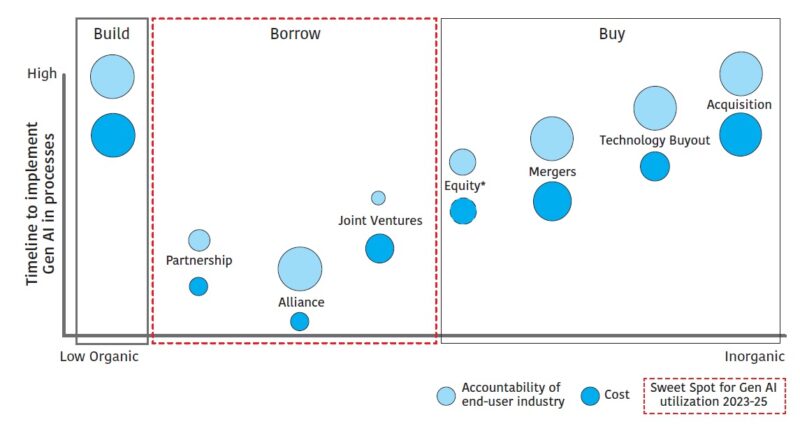Impact of AI Models on Digital Health
Successful digital transformation hinges on effective utilisation of portfolio of AI technologies. Analysis by Reenita Das, Partner and Senior Vice President, Healthcare and Life Sciences at Frost & Sullivan. This article is part of In Focus special issue.
The healthcare industry is prone to the hype created by new technologies that promise to alleviate some of the foundational problems impacting the healthcare system. The introduction and development of data processing technologies from simple data analytics to complex machine learning to generative AI (Gen AI) have created an excitement within the healthcare community about the probable benefits of these technologies in everyday processes and workflows as seen below. The initial excitement is tempered by ethical, legal, regulatory and privacy concerns surrounding the use of personal and healthcare specific information to develop and train new models and programmes.

Globally, governments along with regional groups, vendors and other stakeholders are jointly developing guidelines to define how we can utilise AI to achieve maximum benefit while still maintaining data security and privacy. These guidelines would provide a framework for future development that will help dynamic AI technologies to achieve quintuple aim of better health outcomes, improved patient experience, improved care-giver experience, reduced cost of treatment and focus on value and better health equity.
AI Portfolio – A Key Arsenal in Your Organisation’s Digitalisation Strategy
AI took the healthcare industry by storm due to its diverse applications and scalability. Today, we stand in the era of dynamic AI, where organisations need to incorporate a portfolio of different AI/ML models for different needs, as shown in below chart. The introduction of newer AI models does not degrade the power of earlier models. The launch of Gen AI is considered a game-changer because it has shifted the power of AI from just a handful of IT experts to the common person.

In the healthcare space, this means that all people have now got the resources to innovate and bring new products to the market. However, stakeholders need to take a cautious approach and ensure that their use of the technology is contained ethically and legally. The data used to train the new AI models needs to address the current challenges of bias and hallucinations that are making people hesitant to adopt new technology quickly.
The rise of Gen AI has also put focus on another category of AI – explainable AI. The model provides an explanation about its method and approach to decision making ensuring that the end user is aware of the logic behind the output. Explainable AI has tremendous applications in the healthcare sector, as it could address the biggest roadblock that impacts AI technology – trust in AI-based decision/output. By incorporating this model in the clinical solutions, vendors could increase the adoption of AI in clinical decision making and improve the overall efficiency of the healthcare system.
Priority Areas for AI Utilisation
A Frost & Sullivan survey conducted in 2021 highlighted the priority areas (within 2 – 5 years) for healthcare executives to improve using AI, see chart below. While business process automation was the clear priority, there was interest in using AI to improve patient or customer experience, boost innovation and for data analytics.

Organisations across the globe have taken a keen interest in improving both clinical and non-clinical processes using AI. Vendors large and small are looking to disrupt the market by deploying solutions to cater to the need of the healthcare stakeholders. The solution proposition has shifted from bolt-on or point solutions to enterprise-wide solutions as this results in more interoperable solutions with less vendors to manage.
In terms of customer or patient experience, vendors are deploying AI powered digital front doors (DFDs) that engages patients for both preventive and treatment journeys. The conversational AI agents or chatbots provide near human experience and help patients find their way in the digital environment. In addition, these tools are also being utilised during physician-patient interactions to take notes and transcribe conversation so that the physician could spend more active time with the patients.
Lastly, the use of AI to develop predictive models is the need of the hour. Transition to value-based care models and the focus on population health initiatives cannot succeed if we just continue to conduct descriptive and prescriptive analytics. While these technologies are important to understand the impact of a solution post adoption, it has now become pertinent to predict the behaviour of the system before we implement any change. Predictive analytics will see use in both clinical and operational workflows and will help organisations build digital twins to induce simulated environments for achieving efficiency.
Build-Buy-Borrow Conundrum
New AI releases always renew interest in what this space has to offer as well as how different end-users could utilise it to tackle their current and future challenges. Healthcare organisations want to be at the fore-front yet cautious about deploying AI, including generative AI, in their workflows or processes.
The healthcare system leaders are still trying to untangle the web of technologies that appear on their horizon but can only be utilised or adopted slowly and progressively. These leaders need the support of internal and external stakeholders to navigate the technology and vendor mesh and select the best-fit tools. In addition, to account for the lack of IT expertise, the healthcare systems rely on vendor’s support to implement and maintain the technology. Hence, they achieve quick and maximum gains from the new technology by ‘borrowing’ it from the vendors instead of building it in-house or buying it outright, see chart below.

Governance: Create Foundation and Build Trust Internally and Externally
Healthcare has been one of the laggards in AI adoption due to the nature of the industry that hinges on dealing with the life of a person. Along with traditional problems of data bias and textual data, the adoption is impacted by the false-negative rates and interpretability challenges of earlier AI models. The limited and slow adoption of AI contrasts with the expectation of C-suite executives and developers who perceive the industry to be ripe for transformation through synchronous use of portfolio of AI technologies. This also pushes the regulatory bodies to set boundaries for ethical use of the technology.
AI as a technology is difficult to contain and regulate. A collaborative approach is required between the national governments and active players to develop boundaries around its use. Meanwhile, in the healthcare domain, the risks are far higher as a person’s personal and health data is at risk. Stakeholders need to be extra cautious when developing technology that utilises these data points to build models. Hence, governments globally have taken a side on how they would like to adopt or restrict AI. On one hand, the developed nations are getting particular about the different guidelines of technology adoption and how it will facilitate governance of new tools or products developed by AI. On the other hand, developing nations are working with broad guidelines to combat bias, ethical and discriminatory concerns. In the Middle East, there is focus on using AI for innovations and the UAE has released guidelines to address opportunities and challenges.
In the future, governments and organisations need to build cohesive guidelines to extract maximum benefits from AI tools and regulate the broader technology than specific applications/products. Their proactive stance to develop regulations for current and future technical growth is of utmost important. From the organization’s standpoint, it needs to protect the IP and personal data of the employees and hence, develop strict AI usage policies. In addition, technology developers need to focus on transparency to ensure ethical and legal compliance. Finally, all stakeholders need to create an agile governance structure so that they can incorporate new developments easily without compromising on the current structure.
AI Will Evolve: Will You?
Since COVID-19 pandemic started, we have seen a rapid pace of technological advancements disrupting the healthcare industry, including AI. The use of AI has evolved from just ML or pattern identification to becoming a personal assistant and generating new content. In this process, healthcare systems and vendors that kept pace with the technology and implemented planned adoption survived and proliferated, while the slow or unplanned adopters gradually phased out.
The story is similar for vendors – players who developed integrated or enterprise-wide solutions are reaping success around while bolt-on solution providers are now getting restricted to their niche market and eventually will lose their space to the big players. This depicts the complexity of the healthtech market and the need for all the stakeholders to continuously evolve both in terms of their offerings as well as their adoption in current workflows and processes.
Images by Unsplash

